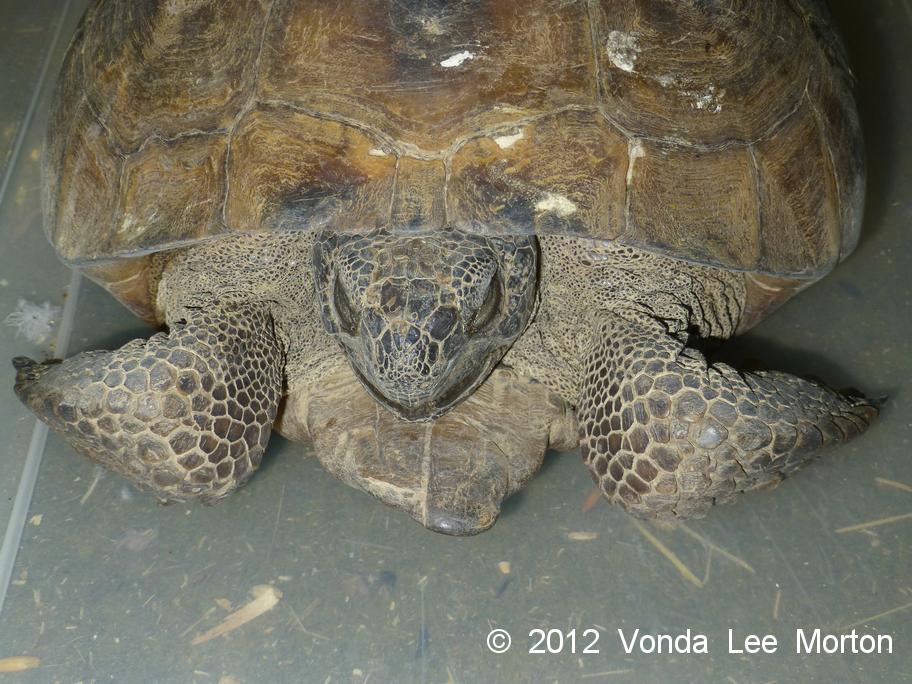|
The squirrels are bouncing off the walls of their cage—literally. I can’t open the door for more than the few seconds it takes to toss in their food; otherwise the spastic little rascals are out and a merry chase ensues to get ‘em back inside. By next week they should be good to go. The folks who found these babies asked that they be allowed to release them back in their yards, so that’s the plan for ‘em now that they’re old enough and eating a wide enough variety of natural foods—natural in this case meaning the stuff they’d find in the wild, not “all natural, no preservatives”…although technically, I suppose it does mean that, too! The doves are in the flight pen now. They look a little bewildered and somewhat bedraggled in the photos; this morning was their first experience with rain. Doves are mostly ground birds, so their tail feathers got a bit muddy, but manic grooming sessions, as you can see from the Eurasian collared’s photo, will soon fix that. This adorable little flying squirrel came in late last week after being attacked by a cat. He was originally taken to raptor rehabber Steve Hicks of Bubba & Friends, and volunteers Amy Rogers and Laurie Jackson coordinated to get him to me. Thanks to Steve for immediately starting him on antibiotics and to Amy & Laurie for getting him to me so quickly. He was a very lucky little fellow; the cat only managed to injure his tail. Flyers use their tails as rudders, but the tails will snap off as a survival mechanism. Unfortunately, flyers can’t glide properly without their tails. This darling will have a permanent kink in his tail, but he’ll still have the entire tail, so his navigation system will be intact! To give you an idea of the flyer’s size, his photos are larger than he is in real-life; he’s only app. 3 inches long, not including his tail, which adds about another 2 inches or so. Remember this gopher tortoise from early August? This nasty gash was easily treatable, but I transferred this guy to Steve Hicks, who had an escape-proof turtle/tortoise pen to hold him while he healed. Last week, Sir Gopher came back to me, at the same time as the flyer, for release. Look at the difference in his shell in just two months! The person who originally found him met me and took him back to his home territory for release. I still have one red bellied woodpecker from the summer randomly insisting on a handout. He calls and fusses and demands until—after holding it up where he can see it—I carefully place a pecan half on one of the platform feeders and step away. Then he flies over and scoots down the tree to the feeder to snag his snack! Fall begins Saturday, hopefully accompanied by actual fall-like temperatures. As the temps cool down and the leaves begin changing, make time to get outside and look for flocks of migrating birds overhead—you never know what you might see. Several years ago, I was lucky enough to have a flock of migrating American robins roost in the woods behind my house. You think one robin’s noisy, try having hundreds of them chattering away at the tops of their lungs. I still grin thinking about seeing the trees filled with gossiping robins!
8 Comments
Ida Blanche Suskind
9/18/2012 07:52:49 am
Each story a treat! I am realizing how very difficult it would be for me to let anyone go 'home'!
Reply
Laurens Wildlife Rescue
9/18/2012 08:13:35 am
Thanks, Kiku!
Reply
Ann Feldman
9/18/2012 08:04:42 am
Oh those squirrels are so adorable! And the doves now look...like doves! What are turtle shells composed of and do they heal from down up? When you mended the shell with epoxy (or crazy glue, I forget which) when the shell healed itself, what happens to the glue? I love migration! Just on a short walk thru a corner of the park on the way to the pool I saw/heard warblers, and spotted my favorite, the Black and White, on a tree trunk. Did you know the Horvaths have two new RT juvies in the Redtail Motail (my name) one from the Bronx and one from lower Manhattan that someone found in their back yard.
Reply
Laurens Wildlife Rescue
9/18/2012 08:27:14 am
Hey Ann! Turtle shells are composed of bone and keratin and do heal from the inside out. When broken bits are epoxied together, the epoxy isn't applied to the exposed bone edges, as this could interfere with bone healing. It's applied to the outer area, which is why epoxy works so well--it hardens quickly.
Reply
pondove
9/18/2012 12:47:35 pm
I know nothing about turtles so find this to be an amazing story with a great ending. Bless you for doing this work. Your website always lifts my heart!
Reply
Laurens Wildlife Rescue
9/18/2012 01:28:20 pm
Thanks, Pon!
Reply
Pipette
9/18/2012 03:32:05 pm
I totally agree with Kiku's comment - all of it!
Reply
Laurens Wildlife Rescue
9/18/2012 03:43:42 pm
Thanks, Pipette! Flyers have personalities to match their sweet little faces; they're just precious. I don't know a single rehabber who doesn't adore 'em.
Reply
Your comment will be posted after it is approved.
Leave a Reply. |
Archives
April 2023
Categories
All
|











 RSS Feed
RSS Feed
